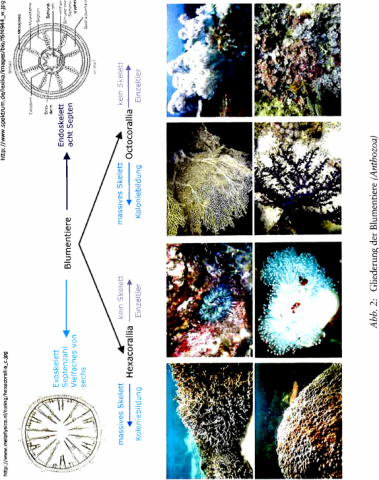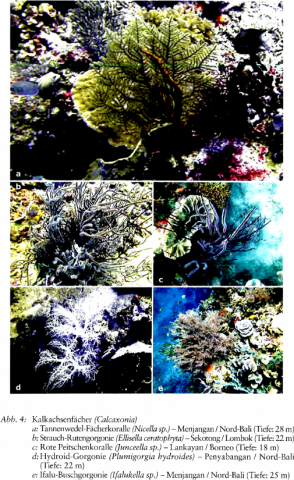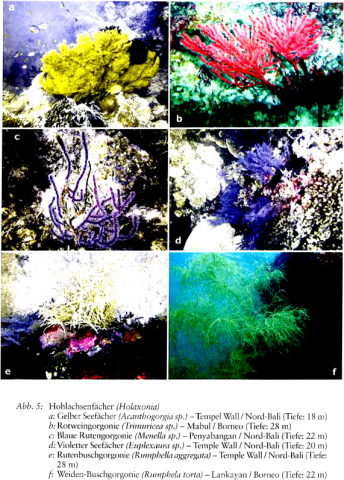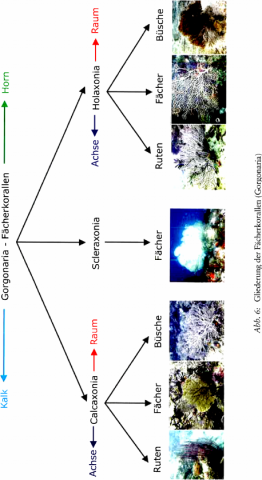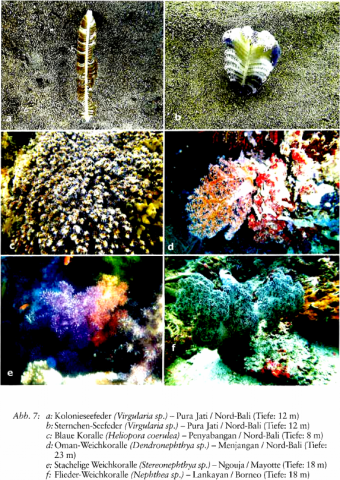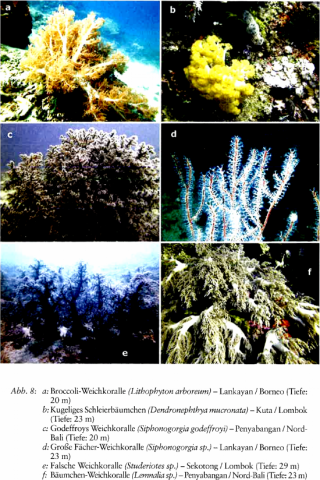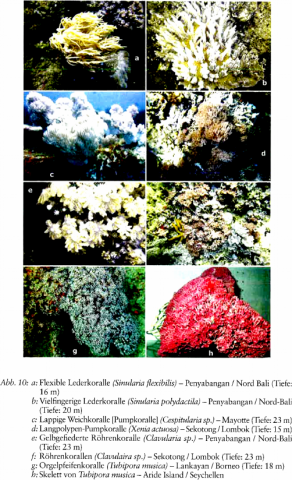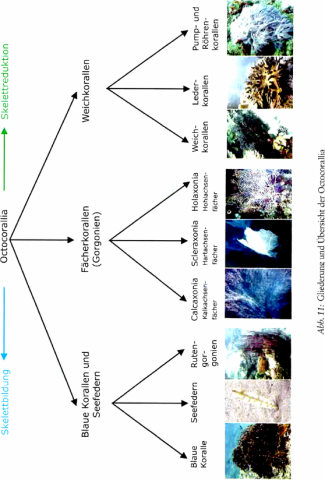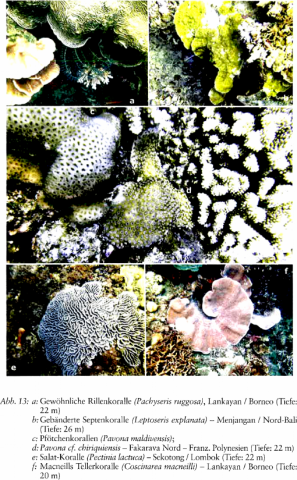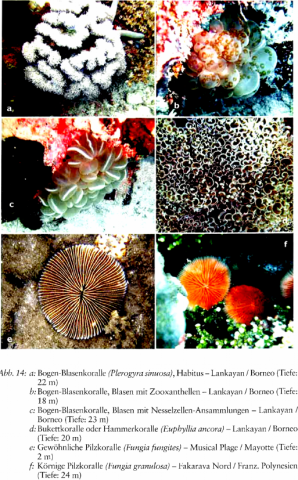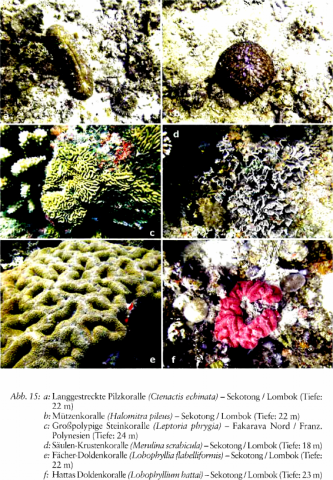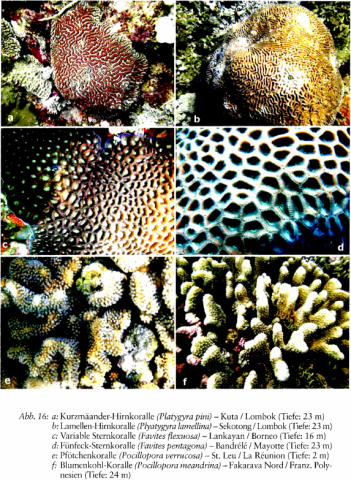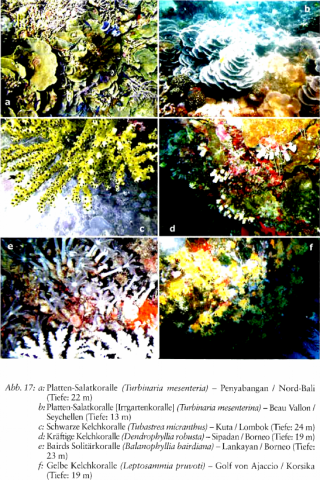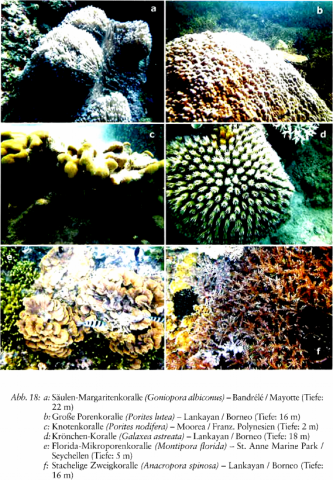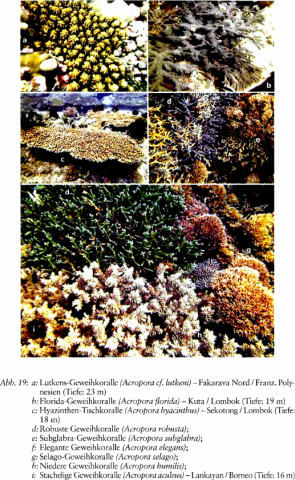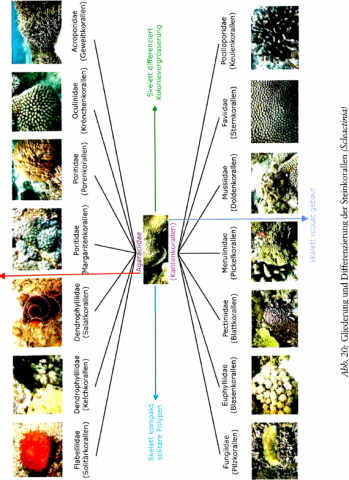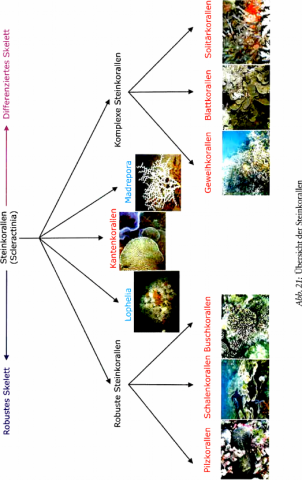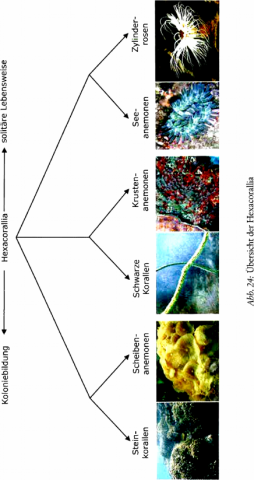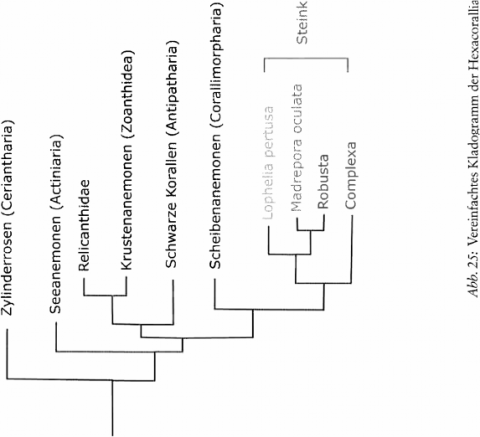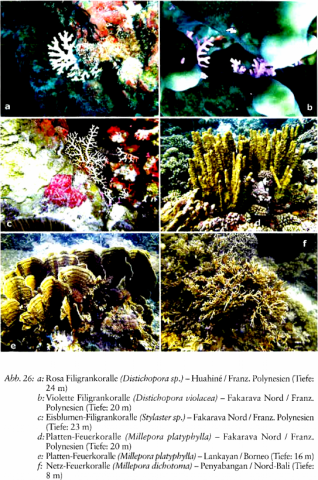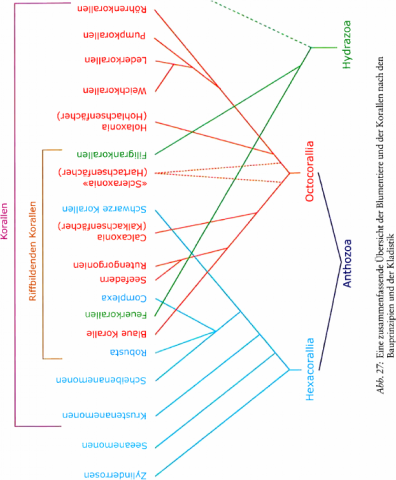Eine Übersicht zur Gliederung der Blumentiere mit besonderer Berücksichtigung der Korallen
Export Article Citation as
- Download price : €6
Abstract:
After a general overview of the phylum Cnidaria with their bilayered structure and two Characteristic life forms, polyp (sessile) and medusa (mobile), the Anthozoa, which comprise their own class, are examined in detail by focusing on the colony- forming Anthozoa, which are also referred to as corals. We can distinguish two fundamentally different formative principles: on the one hand the Octocorallia, which — if present — are distinguished by an endoskeleton and an eightfold polyp symmetry, and on the other hand the Hexacorallia, which — if present — are distinguished by an exoskeleton and an internal symmetrical arrangement of polyps that is always based on multiples of six. Characteristic species are selected and presented from the viewpoint of their biology of form and typical modes of existence. From this, organising principles and a clear classification are gradually developed. From these individual overviews a suggestion for classification is elaborated and related to the results of cladistic research.
References
- AINSWORTH,T. D., HERON, S. F., ORTIZ, J. C & AL. (2016): Climate change disables coral bleaching protection on the Great Barrier Reef. Science 352(6283): 338-342
- BOURNE, D. C., GARREN, M. WORK & AL. (2009): Microbial disease and the coral holobiont. Trends in Microbiology 17(12): 554-562
- BUDD, A. F., ROMANO, S. L., SMITH, N. D., BARBEITOS, M. S. (2010): Rethinking the playlogeny of seleractinian corals: a review of morphological and molecular data. Integrative and Comparative Biology 5 0(3): 411-427
- CAIRNS, S. D., WIRSHING, H. H. (2015 ): Phylogenetic reconstruction of scleraxonian octocorals supports the resurrection of the family Spongiodermidae (Guidaria, Alcyonacea). Invertebrate Systematics 29: 345-368
- CAIRNS, S. D., KITAHARA, M. V. (2012): An illustrated key to the genera and subgenera of the recent azooxanthellate Seleractinia ( Cnidaria, Anthozoa), with an attached glossary. Zoo-Keys 227: 1-47. doi: 10.3897/200key5.227.3612
- COLLINS, A. C., SCHUCHERT, P, MARQUES,A. C. & AL. (2006): Medusozoan phylogeny and character evolution clarified by new large and small subunit rDNA data and an assessment of the utility of phylogenetie mixture models. Syst. Biol. 5 5 ( 1 ): 97-115
- DALY, M., FAUTIN, D. G., CAPPOLA, V. A. (2003): Systematics of the Hexacorallia (Cnidaria: Anthozoa). Zoological Journal of the Linnean Society 139: 419-437 — , BRUGLER, M. R., CARTWIGHT, P.& AL. (2007): The phylum Cnidaria: A review of phylogenetic patterns and diversity 300 years after Linnaeus. Zootaxa 1668: 127-182
- ERHARDT, H., KNOP, D. (2005): Korallenführer Indopazifik. Stuttgart
- FIGUEROA, D. F., BACO, A. R. (2014): Octocoral mitochondrial genomes provide insights into the phylogenetic history of gene order rearrangements, order reversal, and Cnidarian phylogenetics. Genome Biol. Evol. 7(1): 391-409
- FUKAMI, H., CHEN, C. A., BUDD, A. F. & AL. (2008): Mitochondrial and nuclear genes suggest that stony corals are monophyletic but most families of stony corals are not (order Scleractinia, class Anthozoa, phylum Cnidaria). PLOS ONE 3(9): e3222. doi:10.1371/journal. pone.0003222
- FREIWALD, A. (2014): Kaltwasserkorallen — aus der Grundlagenforschung auf die politische Agenda. SENCKENBERG — natur - forschung - museum 144(1/2): 6-17
- KERR, A. M. (2005 ): Molecular and morphological supertree of stony corals (Anthozoa: Scleactinia) using matrix representation parsimony. Biol. Rev. 80: 543-558
- LEINFELDER, R. (2003): Korallenriffe — Zentren der Artenvielfalt und Evolution. In: Hanseh, W (Hrsg.): Katastrophen in der Erdgeschichte. Wendezeiten des Lebens. Museo 19: 180-199
- MCFADDEN, C. S., FRANCE, S. C., SANCHEZ, J. A., ALDERSLADE, P. (2006): A molecular phylogenetic analysis of the Octocorallia (Cuidaria: Anthozoa) based on mitochondrial protein—coding sequences. Molecular Phylogenetics and Evolution 41: 512-527
- MCFADDEN, C. S., FRANCE, S. C., SANCHEZ, J. A., ALDERSLADE, P., OFWEGEN, L. P. VAN (2013): Molecular phylogenetic evidence supports a new family of octocorals and a new genus of Alcyoniidae (Octocorallia, Alcyonacea). ZooKeys 346: 59-83
- MARQUES, A. C., COLLIN, A. G. (2004): Cladistic analysis of Medusozoa and cnida rian evolution. Invertebrate Biology 123(1): 23-42
- OPPEN, M. J. H. VAN, PALSTA, F. P., PIQUET, A. M.-T., MILLER, D. J. (2001 ): Patterns of coral-dino-flagellate associations in Acropora: significance of local availability and physiology of Symbiodinium strains and host-symbiont selectivity. Proceedings of the Royal Society (London) B 268: 1759-1767 (doi:10.1098/rspb.2001.1733)
- RÄDECKER, N., POGOREUTZ, C., VOOLSTRA, C. R. & AL. (2015): Nitrogen cycling in corals: the key to understanding holobiont functioning? Trends in Microbiology 23(8): 490-497
- ROMANO, S. L., CAIRNS, S. D. (2000): Molecular phylogenetic hypotheses for the evolution of seleractinian corals. Bulletin of Marine Science 67(3): 1043-1068
- SAMMARCO, P. W, COLL, J. C. (1992): Chemical adaptations in the Octocorallia: evolutionary considerations. Marine Ecology Progress Series 88: 93-104
- SALVAR, B., BACCHET, PH. (2011): Guide des récifs coralliens de Tahiti et ses iles. Tahiti
- SCHUMACHER, H. (2010): Korallen — Baumeister am Meeresgrund. München
- SPALDING, M: D., RAVILIOUS, C., CREEN, E. P. (2004): Weltatlas der Korallenriffe. Bielefeld
- STAMPAR, S. N., MARONNA‚ M. M., KITAHARA &- M. (2014): Fast—evolvnng mimelumdrial DNA in Ceriantharia: a reflection of Hexacorallia paraphyly? PLOS ONE 9(1): e86612. doi:10.1371/journal.pone.0086612
- STOLARSKI‚ J., MARCELO, V., KITAHARA, M. V. & AL. (2011): The ancient evolutionary origins of Scleractinia revealed by azooxanthellate corals. BMC Evolutionary Biology 2011: 316-327
- VERON, J. E. N. (1995): Corals in space and time. The Biogeography and Evolution of the Seleractinians. Sydney


